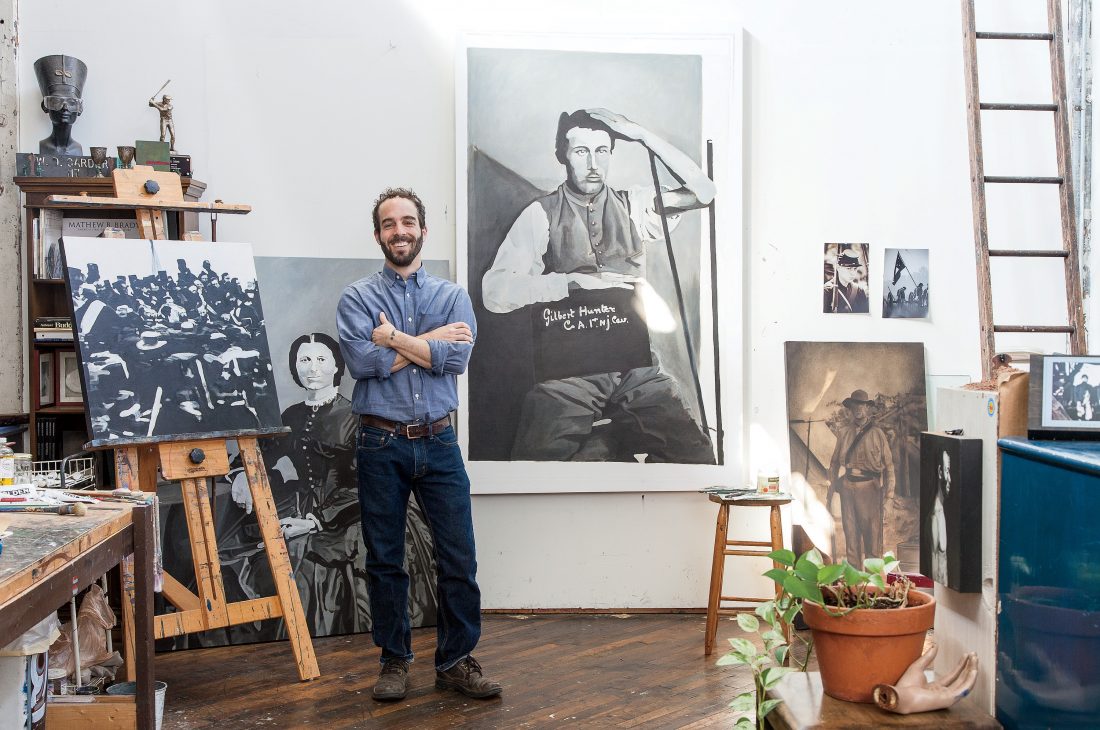I’m sitting across from Dane Carder at Prince’s Hot Chicken Shack, north of downtown Nashville, with our lips on fire and sweat running down our faces. It’s like hot yoga without any of the health benefits and, as it turns out, a food obsession the artist and I share.
This past March, renowned Memphis art dealer David Lusk teamed up with Carder to open the first David Lusk Gallery in Nashville, with Carder at the helm. A beautiful contemporary space in the burgeoning Wedgewood-Houston neighborhood, the gallery aims to spotlight the city’s vibrant and expanding arts community. But I first met the forty-two-year-old artist when he contacted me about his own work, an ongoing series of paintings inspired by another of our shared passions: the Civil War. It’s a subject he has been exploring in his art for nearly a decade, earning a loyal and growing following among collectors and critics alike.

Photo: Caroline Allison
Departure Portrait
Carder bases his paintings on Civil War–era photographs, imagery that has come into renewed focus in the midst of the war’s sesquicentennial. But rather than depict the war from a strictly historical perspective, illustrating high-level officials or major events in fine detail the way many artists of the genre do, Carder takes a more universal approach. As the Civil War was the first war extensively documented with a camera, he has the opportunity to portray not just generals and politicians but all involved—from slaves and common foot soldiers to amputees and the women left behind, white and black. “It’s long been my desire to create meaningful work, to make paintings with historical weight and humanitarian resonance,” Carder says. At heart, his images speak to timeless themes of compassion and loss. “Having experienced the devastating loss of my dad as a child, I believe that my eventual triumph over grief, and the materialization of hope in my life, connect me to the narrative of the country after the Civil War.”
Before he begins each piece, Carder pores over period photographs from his collection of reference books, thoughtfully—almost meditatively—seeking out just the right image to render on canvas. Upon first glance, the paintings, which range from as small as three and a half by two inches to as big as four by seven feet, seem a hair removed from photorealism. But as you make your way through the series, you notice something more going on. Images are out of focus in some works while others deconstruct battles and their aftermath entirely into the abstract. Just as the dead on the fields of Antietam have now faded from sight, so too do Carder’s forms begin to blur and recede.

Photo: Caroline Allison
A Civil War-era photograph from Carder’s reference collection.
In November 19, 1863, named for the date of Lincoln’s Gettysburg Address, he emphasizes the unifying power of the moment by blending the crowd into a mostly faceless collection of light and dark shapes, much the way they might appear in a film negative. Other images are intentionally personal, reminders of the war’s human impact. In Departure Portrait, for example, Carder captures a husband and wife in the moments before he heads off to battle, their tenderness mixed with the harsh reality of all they face.
“I have a sort of conversation with the images as I work with them, listening for what they need to help communicate their message,” he says. “My goal is not to tell a particular story, as much as to tell the bigger story.”
Photo: Caroline Allison
Carder bases his paintings on Civil War-era photographs and imagery.
1 of 4
Photo: Caroline Allison
Carder’s images speak to timeless themes of compassion and loss.
2 of 4
Photo: Caroline Allison
Before Carder begins a piece, he pores over period photographs from his collection of reference books.
3 of 4
Photo: Caroline Allison
Dane Carder in his Nashville studio.
4 of 4












